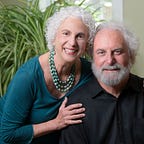The Choice
Succumbing to bitterness or choosing life
Edith Eva Eger is one of the few remaining Holocaust survivors. She was born in 1927 in the town of Kosice, in what was then Hungary, into a middle-class family where her father was a respected tailor. She had two sisters, Magda and Klara.
Edith was a good student, excelling in ballet and gymnastics. From her earliest beginnings, she was a passionate child who excelled in all school subjects and loved gymnastics and all forms of dancing, particularly ballet. At the age of 16, she was chosen as a member of the team that was training for the Olympics, but soon afterward was cut from the team when it was revealed that she was Jewish.
Shortly thereafter, German soldiers who had occupied Kosice came into her home and imprisoned her family and the other nearly 12,000 Jews of Kosice in a brick factory at the edge of town. She and her family were transported in a cattle car to the German death camp Auschwitz in Poland. There, Joseph Mengele, who is known as the Angel of Death, greeted them. Upon entering the camp, both her parents were immediately sent to the gas chambers and executed. Her mother’s parting words, planted in Edith’s mind, were, “Just remember, no one can take away from you what you’ve put in your mind.”
Later on that same evening, Dr. Mengele came into Edith’s barracks, looking for someone to entertain him. Aware of her talent as a dancer, several girls pushed Edith forward. The musicians began to play the Blue Danube Waltz, and Mengele turned towards Edith and nodded for her to dance. Shocked and overwhelmed by the loss of her parents, Edith forced herself to dance to the music.
Because of the starvation (literally!) rations given to the prisoners in the camp, Edith lost nearly half of her body weight. Every day, she lived with the uncertainty of not knowing if she will live or die. Despite the loss of her physical health and strength, Edith’s spirit remained strong and vibrant. Her sister Magda stayed close to her, co-creating a mutual support system for survival.
Towards the end of the war, the Germans emptied the prison of most of its inmates and put them on a forced march in the dead of winter to Gunskirchen, another prison camp. Exhausted and weakened by disease and famine, only 100 of the 2,000 prisoners who began the march survived it. Edith, who sustained a broken back on the march, and her sister Magda were among the survivors.
They arrived at a camp built to house about 300 slave laborers into which over 18,000 people were crowded. Most of the inmates were suffering from rampant disease, typhus, dysentery, lice, and open sores. There was only one 20-hole latrine for the 18,000 inmates. A few days after entering the camp, American armed forces liberated it.
Barely alive, and weakened by starvation, Edith was left for dead and was lying amidst a pile of corpses. Miraculously, one of the GI’s who liberated the camp noticed a slight movement in one of Edith’s fingers. He pulled the dead bodies under which Edith was partially buried off of her and noticed that she was still breathing. She was then literally raised from the dead. At the time, she weighed 70 pounds. He separated her from the dead. Had he not noticed that she was still breathing, she would have died there among the dead.
Although one might assume that Edith’s liberation from the Nazi prison camps would mark the end of her suffering, this was not to be the case. The worst was over, but many challenges and more hardships awaited Edith in the coming months and years. She goes on to describe and document her many challenges and incredible achievements that she has accomplished in her 91 years, all of which are offered with modesty and the implicit message that we are all capable of choosing whether to succumb to the paralysis of bitterness and despair or to choose life, to choose love, even to choose forgiveness in the face of indescribable brutality.
And even though we can’t always make what we consider to be the “correct” choice, we can choose to forgive ourselves and accept our own compassion for doing our best. Edith also made the choice of using her life experiences to become a healer of hearts and souls that have been wounded and damaged in the course of living.
Her story is not simply one of survival in the face of unimaginable odds and indescribable physical and emotional suffering. It is much more than that. It is a testament to the strength and even the indestructibility of the human spirit and an inspiration to anyone who may have ever faced inner or outer obstacles that threaten their well-being or even their very existence.
She was not broken by the torture, starvation, and constant threat of death she endured as a teenager but was emboldened and strengthened by those experiences. She teaches hope, recovery, possibilities, resilience, and compassion. To find out more about this extraordinary woman, read her inspiring memoir, The Choice: Embrace the Possible. She is a profoundly gifted healer, as evidenced in her book and in the many presentations that she has done in her talks, interviews, and videos, many of which are available on YouTube and TED talks.
We’re giving away 3 e-books absolutely free of charge. To receive them just click here. You’ll also receive our monthly newsletter.
